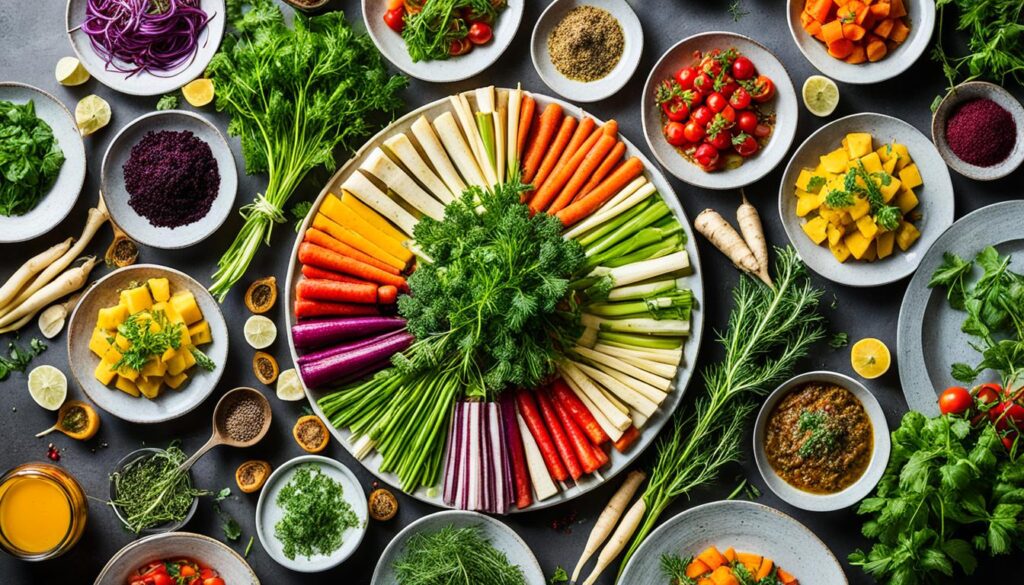Parsnips are a versatile and nutritious root vegetable that can be enjoyed in a variety of ways. In this article, we will provide tips for buying, cooking, and savoring parsnips. Whether you’re a seasoned cook or new to these winter vegetables, you’ll find plenty of inspiration and guidance for incorporating parsnips into your healthy cooking routine.
Key Takeaways:
- Parsnips are a healthy and delicious addition to your diet.
- They are a root vegetable, rich in vitamins and fiber.
- Look for firm and bright-colored parsnips when buying.
- Store parsnips in a cool, dark place for up to a month.
- Parsnips can be roasted, boiled, mashed, or used in soups and stews.
How to Choose and Store Parsnips
When it comes to buying parsnips, there are a few key things to keep in mind to ensure you select the best ones. By following these tips, you can bring home fresh and flavorful parsnips for your culinary creations.
Tips for Buying Parsnips
- Look for firmness and bright color: Choose parsnips that are firm to the touch. They should have a vibrant, creamy-white color, indicating their freshness.
- Avoid soft or mushy parts: Check for any soft or mushy spots, as this may indicate spoilage or poor quality.
- Inspect the tops: It’s normal for parsnips to have woody tops, but make sure they are not molded.
- Don’t worry about roots: If your parsnip has roots growing off the sides and bottom, that’s perfectly fine. You can simply cut them off before cooking.
Storing Parsnips
Proper storage is essential to maintain the freshness and flavor of parsnips. Here’s how to store them:
| Method | Storage Duration | Tips |
|---|---|---|
| In the refrigerator | Up to 2 weeks | Place parsnips in a perforated plastic bag and store them in the crisper drawer. |
| In the freezer | Up to 12 months | Peel and chop parsnips, blanch them briefly, then store in an airtight container or freezer bag. |
Remember, parsnips are root vegetables, so they thrive in cool and dark environments. Make sure to give them some breathing room in the refrigerator, and they’ll stay fresh for longer.
Cooking with Parsnips: Tips and Recipe Ideas
Parsnips are a versatile ingredient in the kitchen and can be prepared in various ways. Whether you’re roasting, boiling, steaming, mashing, or pureeing them, parsnips add a sweet and nutty flavor to your dishes. Here are some ideas and tips for cooking with parsnips:
Roasting Parsnips with Root Vegetables
One delicious way to enjoy parsnips is by roasting them with other root vegetables. This method brings out their natural sweetness and enhances their flavors. Here’s a simple recipe to try:
| Ingredients | Instructions |
|---|---|
|
|
Parsnip Fries
If you’re looking for a healthier alternative to regular fries, try making parsnip fries. They are deliciously crispy and packed with flavor. Here’s a quick and easy recipe:
| Ingredients | Instructions |
|---|---|
|
|
Parsnip Soup
Soup recipes are another great way to incorporate parsnips into your meals. Their sweet and nutty flavor adds depth to any soup. Here’s a simple parsnip soup recipe:
| Ingredients | Instructions |
|---|---|
|
|
These are just a few examples of how you can incorporate parsnips into your cooking. Get creative and explore different recipes and flavor combinations to find your favorite way to enjoy this delicious and nutritious root vegetable.
Flavor Combinations and Pairings
Parsnips, with their mildly nutty flavor, are a versatile ingredient that pairs well with a variety of flavors. Whether you’re cooking with spices, herbs, sweet flavors, fruits, vegetables, dairy, or meats, there are endless possibilities to enhance the taste of parsnips.
When it comes to spices, try adding a pinch of nutmeg, ginger, or garlic to bring out the best in parsnips. These spices complement the earthy and sweet notes of the vegetable, creating a harmonious blend of flavors.
Herbs like parsley, rosemary, and thyme also work wonders with parsnips. Their aromatic profiles add depth and freshness to dishes, elevating the overall taste and aroma.
If you have a sweet tooth, don’t be afraid to explore the world of sweet flavors when cooking with parsnips. Maple syrup and honey are excellent choices to enhance the natural sweetness of parsnips, creating a delightful balance of flavors.
Incorporating fruits and vegetables into your parsnip dishes can add both texture and complementary flavors. Apples, carrots, and potatoes pair particularly well with parsnips, resulting in dishes that are both flavorful and visually appealing.
Dairy products like Parmesan and other hard cheeses can be used to add richness and creaminess to parsnip-based recipes. The combination of cheese and parsnips creates a delectable fusion of flavors that is sure to impress your taste buds.
If you’re a meat lover, consider pairing parsnips with meats like bacon and chicken. The savory flavors of these meats complement the natural sweetness of parsnips, resulting in a satisfying and well-rounded dish.

Sample Flavor Pairing Ideas:
- Roasted parsnips with garlic and thyme
- Mashed parsnips with maple syrup and butter
- Parsnip and apple soup with a hint of nutmeg
- Sautéed parsnips and carrots with rosemary
- Parmesan-crusted parsnip fries
- Bacon-wrapped parsnip skewers
Health Benefits of Parsnips
Parsnips are not only delicious but also offer several health benefits. They are a good source of dietary fiber, which supports digestive health. They also contain significant amounts of vitamin C, which is essential for a healthy immune system. Additionally, parsnips provide folate, a B-vitamin important for cell growth and development. They are also a source of potassium, an essential mineral for heart health.
| Nutrient | Amount per 100g |
|---|---|
| Dietary Fiber | 4.9g |
| Vitamin C | 17.1mg |
| Folate | 71μg |
| Potassium | 375mg |
Fun Facts About Parsnips
Parsnips are not only a versatile and delicious vegetable, but they also have a fascinating history and a range of culinary uses. Let’s explore some interesting facts about parsnips!
Historical Significance
Parsnips have been cultivated for centuries and have a rich history. They were originally cultivated by the Romans, who valued them for their sweet flavor and medicinal properties. In fact, parsnips were used as a sweetener before cane sugar became widely available in Europe.
Culinary Versatility
Parsnips can be used in a variety of dishes, adding a unique flavor and texture. They are commonly used in savory soups and stews, where their natural sweetness enhances the overall taste. Additionally, parsnips can be roasted to bring out their nutty and caramelized flavors. They can also be mashed, pureed, or even enjoyed raw in salads.
Year-Round Availability
While parsnips are in season during the fall, winter, and spring months, they are often available in stores year-round. This means you can enjoy their delicious taste and nutritional benefits at any time.
| Parsnips Facts: |
|---|
| Parsnips have a mildly sweet and nutty flavor. |
| They are a great source of dietary fiber. |
| Parsnips are rich in vitamin C, providing immune-boosting benefits. |
| They also contain folate, a B-vitamin important for cell growth. |
| Parsnips are a good source of potassium, which supports heart health. |
Discover the many ways you can incorporate parsnips into your meals to add flavor and variety to your culinary repertoire!
Conclusion
Incorporating parsnips into your diet is a wonderful way to enhance your healthy eating habits. With their sweet and nutty flavor, parsnips offer a unique taste experience that can be enjoyed in a wide variety of dishes. Whether you’re roasting them to bring out their natural sweetness, mashing them for a creamy side dish, or adding them to soups and stews for an extra layer of flavor, parsnips are sure to delight your taste buds.
Not only are parsnips delicious, but they also provide numerous health benefits. They are a rich source of dietary fiber, which supports a healthy digestive system. Additionally, parsnips are packed with vitamin C, an essential nutrient for a strong immune system. They also contain folate, a B-vitamin that is important for cell growth and development, as well as potassium, which is vital for maintaining heart health.
When cooking with parsnips, consider experimenting with different recipes and flavor combinations to find your favorite way of enjoying this versatile root vegetable. Whether you’re a seasoned cook or a novice in the kitchen, parsnips offer endless possibilities for creating delicious and nutritious meals. So, don’t hesitate to incorporate parsnips into your winter cooking and discover the joy of this amazing vegetable.
FAQ
How do I choose the best parsnips?
When selecting parsnips, look for firmness and bright color. Avoid parsnips with soft or mushy parts. It’s normal for parsnips to have woody tops, but make sure they are not molded. If your parsnip has roots growing off the sides and bottom, that’s perfectly fine. You can cut them off before cooking.
What are some ways I can cook parsnips?
Parsnips can be roasted, boiled, steamed, mashed, or pureed. Try roasting them in the oven with other root vegetables for a flavorful side dish. You can also make parsnip fries as a healthier alternative to regular fries. Parsnips add a sweet and nutty flavor to soups and stews, and they can be pureed to create a creamy sauce.
What flavors pair well with parsnips?
Parsnips go well with spices like nutmeg, ginger, and garlic, as well as herbs like parsley, rosemary, and thyme. Sweet flavors like maple syrup and honey complement the natural sweetness of parsnips. Fruits and vegetables like apples, carrots, and potatoes can be combined with parsnips in various dishes. Parmesan and other hard cheeses, as well as meats like bacon and chicken, are also great companions for parsnips.
What are the health benefits of parsnips?
Parsnips are a good source of dietary fiber, which supports digestive health. They also contain significant amounts of vitamin C, which is essential for a healthy immune system. Additionally, parsnips provide folate, a B-vitamin important for cell growth and development. They are also a source of potassium, an essential mineral for heart health.
Do parsnips have any interesting facts?
Parsnips were cultivated by the Romans and were even used as a sweetener before cane sugar came to Europe. In the kitchen, parsnips can be used in a variety of dishes, from savory soups to sweet desserts. They can be boiled, roasted, mashed, or even eaten raw. Parsnips are in season in fall, winter, and spring, although they can often be found in stores year-round.
How can I incorporate parsnips into my diet?
Consider roasting, mashing, or using parsnips in soups and stews to enjoy their unique taste and texture. Experiment with different recipes and flavor combinations to discover your favorite way to enjoy this versatile root vegetable.







